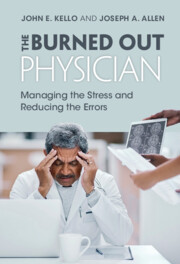Book contents
- The Burned Out Physician
- The Burned Out Physician
- Copyright page
- Dedication
- Contents
- Figures and Tables
- Preface
- Acknowledgments
- Chapter 1 The Psychology of Burnout
- Chapter 2 The Burned-Out Physician
- Chapter 3 Types of Medical Error
- Chapter 4 Sources of Medical Error
- Chapter 5 How-To Strategies for Addressing the Crisis
- Chapter 6 Solution #2: Engage in Self-Care
- Chapter 7 Solution #3: Seek Social Support
- Chapter 8 Solution #4: Follow the Advice You Would Give Patients
- Chapter 9 Solution #5: Perform Effective Team Leadership
- Chapter 10 Solution #6: Ensure Collaborating Team Members
- Chapter 11 Solution #7: Establish and Sustain a Positive Team Culture
- Chapter 12 Solution #8: Make Changes in Workflow in Organizations
- Chapter 13 Solution #9: Make Changes in Management Practices in Local Healthcare System Top Leaders
- Chapter 14 Solution #10: Make Changes in Overall Healthcare System Processes
- Chapter 15 Solution #11: Make Changes in National Healthcare
- Chapter 16 Saving the Burned-Out Physician
- Index
- References
Chapter 16 - Saving the Burned-Out Physician
Published online by Cambridge University Press: 08 July 2022
- The Burned Out Physician
- The Burned Out Physician
- Copyright page
- Dedication
- Contents
- Figures and Tables
- Preface
- Acknowledgments
- Chapter 1 The Psychology of Burnout
- Chapter 2 The Burned-Out Physician
- Chapter 3 Types of Medical Error
- Chapter 4 Sources of Medical Error
- Chapter 5 How-To Strategies for Addressing the Crisis
- Chapter 6 Solution #2: Engage in Self-Care
- Chapter 7 Solution #3: Seek Social Support
- Chapter 8 Solution #4: Follow the Advice You Would Give Patients
- Chapter 9 Solution #5: Perform Effective Team Leadership
- Chapter 10 Solution #6: Ensure Collaborating Team Members
- Chapter 11 Solution #7: Establish and Sustain a Positive Team Culture
- Chapter 12 Solution #8: Make Changes in Workflow in Organizations
- Chapter 13 Solution #9: Make Changes in Management Practices in Local Healthcare System Top Leaders
- Chapter 14 Solution #10: Make Changes in Overall Healthcare System Processes
- Chapter 15 Solution #11: Make Changes in National Healthcare
- Chapter 16 Saving the Burned-Out Physician
- Index
- References
Summary
Burnout among physicians and other healthcare providers is a crisis of epic proportions, both in the United States and in other countries as well. Of the many negative outcomes of this stress-related syndrome – and there are many – medical error is especially troubling. Doctors and others who are experiencing the syndrome are more likely to make mistakes, which can be fatal. Potential solutions to reducing the risk of burnout include individual strategies for stress management, team-based strategies for mutual support, and profoundly impactful systems-based strategies at the level of the local organization and more broadly at the national/governmental levels. The adaptive improvement model (AIM) provides a simple, user-friendly structure for identifying burnout-reduction actions aimed at individual, team, or system levels. More broadly, capturing and learning from the lessons of the pandemic will help all of us be more resilient when that immediate crisis is finally past, and we are into the “next normal.”
Keywords
- Type
- Chapter
- Information
- The Burned Out PhysicianManaging the Stress and Reducing the Errors, pp. 199 - 213Publisher: Cambridge University PressPrint publication year: 2022



